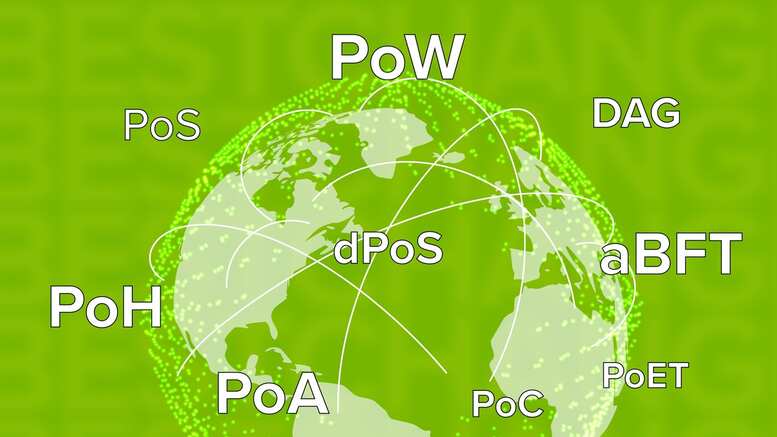
Consensus mechanisms are what transform a blockchain from just a database into a trustless, decentralized infrastructure. They define who validates transactions, how security is maintained, how scalable the network is, and ultimately, how accessible blockchain technology becomes for users and developers alike.
At Titanwhale, we specialize in blockchain infrastructure and protocol design. In this article, we provide a high-level comparison of major consensus models — from the proven Proof-of-Work (PoW) to emerging paradigms like DAG (Directed Acyclic Graphs) and hybrid next-generation frameworks.
Proof-of-Work (PoW): Security Through Computation
PoW was the original consensus model, made famous by Bitcoin and early Ethereum.
In this system, validators (miners) compete to solve complex mathematical puzzles. The first to solve the puzzle earns the right to add the next block to the chain.
Pros:
- Extremely high level of security;
- Proven long-term resilience (e.g., Bitcoin);
- Resistant to manipulation unless a 51% attack occurs.
Cons:
- High energy consumption and environmental concerns;
- Low scalability (limited transactions per second);
- Centralization of mining power in large pools.
While PoW remains the gold standard for trustless security, it is increasingly being replaced by more energy-efficient and scalable models.
Proof-of-Stake (PoS): Security Through Capital Commitment
PoS represents a shift from computational power to economic stake.
Validators are chosen to create new blocks based on the amount of cryptocurrency they lock in (stake) as collateral.
Pros:
- Very low energy consumption;
- Higher throughput compared to PoW;
- Enables broader participation through token delegation.
Cons:
- Risk of wealth centralization;
- “Nothing-at-stake” problem (validators may try to validate multiple chains);
- Heavy reliance on economic incentives and slashing penalties.
Ethereum’s switch to PoS in 2022 marked a turning point toward sustainable, scalable decentralization in public blockchains.
Delegated Proof-of-Stake (DPoS): Speed via Representative Validators
DPoS is a streamlined variant of PoS, where token holders elect a limited number of trusted validators (typically 21–100) to produce blocks on their behalf.
Pros:
- High transaction speeds;
- Low fees;
- Easier governance and network upgrades.
Cons:
- More centralized by design;
- Prone to validator collusion or cartelization;
- Large stakeholders can manipulate voting outcomes.
DPoS powers blockchains like EOS, TRON, and WAX, which prioritize high performance and throughput for consumer-facing applications.
Directed Acyclic Graph (DAG): A Blockchain Without Blocks
DAG is not a blockchain in the traditional sense but rather a graph-based structure, where transactions themselves validate each other without forming blocks.
Pros:
- Theoretical scalability is extremely high;
- No miners or traditional validators;
- Often zero or near-zero transaction fees.
Cons:
- Security mechanisms are still experimental;
- Complex confirmation logic;
- Lack of widely adopted standards or toolkits.
DAG underpins networks such as IOTA, Nano, and partially Fantom, offering a radically different take on distributed consensus.
Hybrid and Emerging Models: Tendermint, Avalanche, Proof-of-History, and Beyond
Modern blockchains often combine multiple consensus mechanisms to strike a balance between security, scalability, and decentralization. Some notable examples include:
- Tendermint (Cosmos)– PBFT-based PoS with fast block finality;
- Avalanche Consensus– random sampling with probabilistic finality;
- Proof-of-History (Solana)– cryptographic time-stamping for ultra-fast throughput;
- Nominated PoS (Polkadot)– a flexible validator-nominator model for governance and security;
- Proof-of-Authority (PoA)– centralized validator sets for permissioned or enterprise blockchains.
These models are purpose-built to match specific ecosystems and use cases — from public smart contract platforms to private enterprise chains.
Titanwhale’s Perspective: No Perfect Consensus, Only the Right One
At Titanwhale, we believe consensus models should be treated as tools, not ideologies. The choice between PoW, PoS, DPoS, DAG, or hybrid systems depends entirely on:
- The purpose of the network (DeFi, enterprise, gaming, IoT, etc.);
- Prioritization of security, scalability, or decentralization;
- The project’s lifecycle, funding, and compliance obligations.
We encourage teams to evaluate consensus mechanisms not only by technical metrics, but also by their governance implications, stakeholder incentives, and long-term adaptability without hard forks.
Titanwhale: We Build at the Architectural Layer
Consensus is not just a protocol decision — it’s an architectural philosophy.
It determines how trust is formed, how data is verified, and how future innovation is unlocked.
At Titanwhale, we help teams assess, design, and implement the right consensus layer based on the project’s unique vision, technical goals, and business context.
Read More: Molly Elizabeth Brolin





